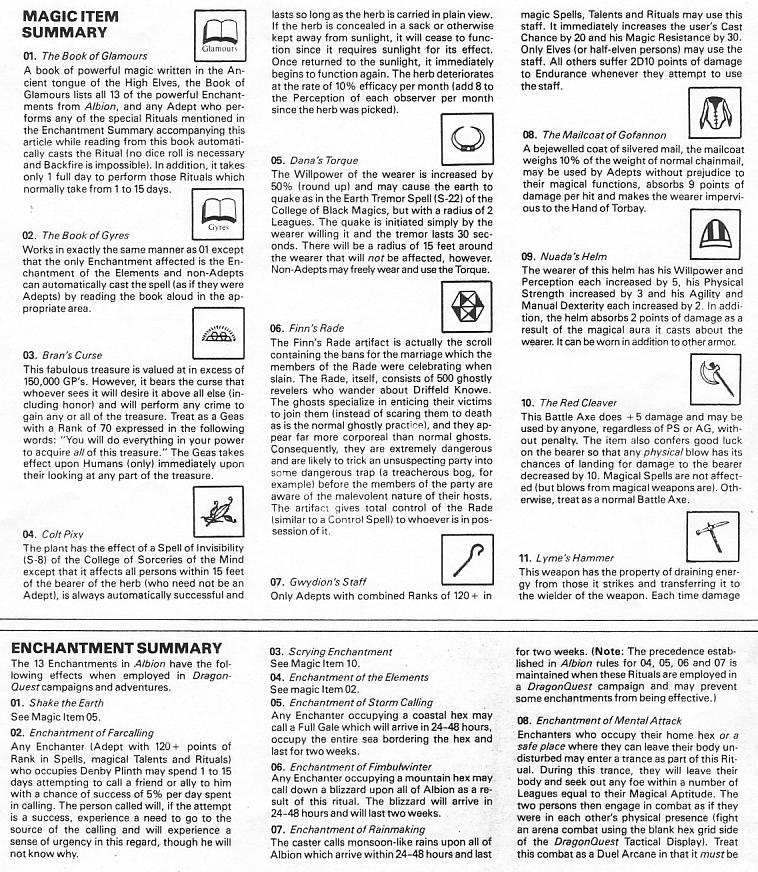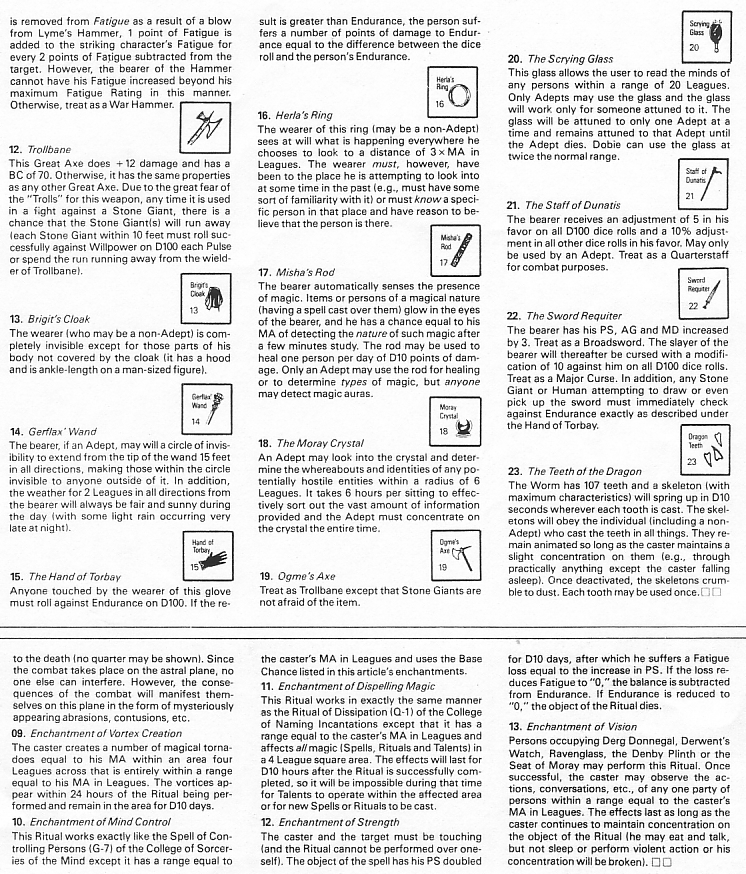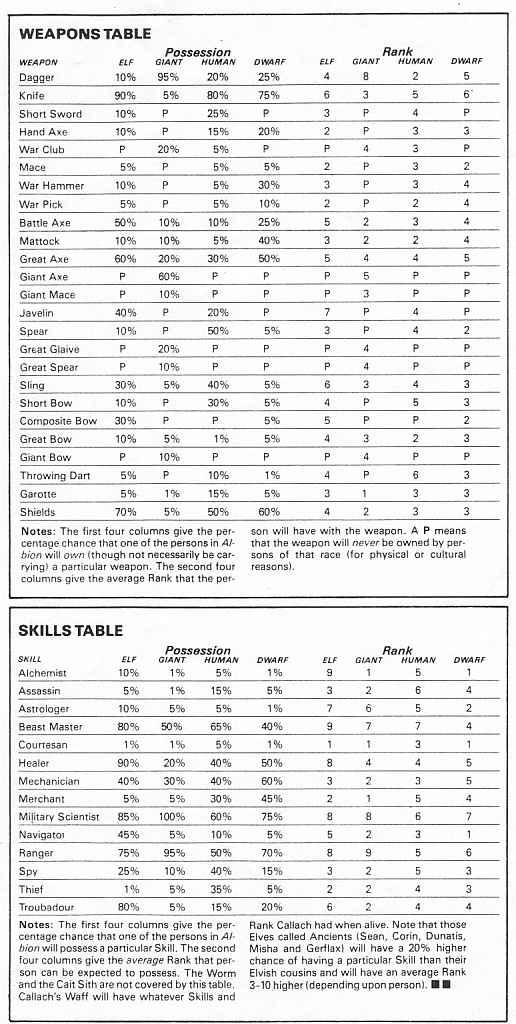
From Ares#12
VARIANT
Adventures in Albion
Role-Playing in the Land of Faerie
by David J. Ritchie
Practically my first thought upon finishing Albion for Ares 11 was: "I
want to do more with this world." Of course, that's not a unique idea.
Most designers these days tend to think in terms of systemic multiverses
("...and then there's the minigame version, and, after that, a computer
game...and then we can do a source book..."). The fact is the tendency
probably started when God spent much of the Seventh Day daydreaming
about what other nifty things he could do with his universe. Be that as
it may, one of the concepts which most naturally presented itself was to
find a way to marry the world of Albion with the DragonQuest system.
The crucial problem in consumating such a marriage is that the Albion
game contains many elements analogous to DragonQuest, but few real
equivalencies. Thus, Albion's Elves and Humans are equivalent to
DragonQuest's Elves and Humans, but Trolls and Gnomes in the boardgame
bear little resemblance to the beings of that name in DragonQuest.
Therefore, the main focus of this article will be upon the conversion of
the numbers and terminology applying to the Persons, Magic Items,
Enchantments and Places of Power in Albion into numbers and terms
understandable to DragonQuest players.
The Characteristics Summary for Dwellers in Albion lists each of the
Persons represented in Albion. followed by their DragonQuest
characteristics (PS, MD, AG, EN, MA, WP, FT, PC, and PB), Aspect, Type
(Race or type of entity), Magical College (if any), Spells, Rituals and
Magic Talents known (if any), Skills known and the number of Weapons the
Person is likely to have Rank in. The average Rank for each Spell,
Talent, Ritual, Skill or Weapon is listed after each ranked ability. The
Skills Table lists the likelihood of a Person knowing a particular Skill
(based on Race) and what his Rank with that Skill is likely to be. The
Weapons Table lists the type of Weapons typically found in Albion, who
will know how to use them and at what Rank in the same manner as the
Skills Table. Using these three items together, it should be possible to
convert Albion Persons into DragonQuest NPC's of approximately the same
strength.
When using the Summary and the two Tables provided, Albion Gnomes are
considered to be equal to DragonQuest Dwarves in all ways except that
the traditional Dwarvish antipathy toward Elves is ignored for all such
Persons resident in Albion. Albion Trolls are, in actuality, Stone
Giants (though Trolls or Fomorians are the terms usually applied by the
Elves to refer to them). Wherever Giants are referred to in these rules,
Stone Giants are meant. The Cait Sith is a Demonic President for
purposes of conjuration, and the ritual necessary to bringing it onto
this plane involves the sacrifice by torture of a progression of House
Cats until the Cait Sith appears. The Cait Sith's specific Skills,
Spells and Ranks will have to be determined by the GM whenever it is
used in a DragonQuest campaign. The Worm is identical to a Green Dragon
in all ways except that it has no wings and all references to wings or
flying should be ignored. Callach's Waff is a Wight, retaining all the
Skills and Weapon Ranks assigned to Callach, but without Callach's
magical abilities. The Ancients are simply longl-ived Elves.
All Enchanted Hexes and Wild Magic Hexes on the Albion map are treated
as High Mane areas and all Mundane Hexes are treated as Low Mane areas
for purposes of DragonQuest adventures in Albion. Terrain types are
equivalent except as follows: Clear hexes should be treated as Fields
for purposes of Encounters; Faerie roads will constantly change location
and direction when non-Elves attempt to use them; Plains and Wastes do
not exist in Albion; Caer Brandingle, Caer Oonagh, The Driffeld Knowe
and Forador are all treated as Ruins; Wigan's Pen is treated as a Crypt;
The Mousa Stour, all Faerie Knowes and Gnomish Delvings are treated as
Caverns (unless fully occupied by their residents at the time a party
enters them); Cuillan Braes, Deng Donnegal, Derwent's Watch, Fir Chlis,
Fir Darrig, Gil's Rest, Kelpie Braes, Povis Heath, Ravenglass, Rona's
Bath, Deniby Plinth, The Giant's Dance and the Seat of Moray are all
considered Places of Power for purposes of the DragonQuest rules and the
appropriate benefits for Adept's of the College of Earth Magics apply to
them; Fir Chlis, Fir Darrig, Povis Heath and The Giant's Dance are all
places where blood sacrifice has been habitually performed so that only
Druidic Earth Magicians can benefit from occupying them; Dermot's Dyke
is treated as an Extreme Danger Level-Field...all other non-fortress
hexes are High Danger areas. Treat a league as a mile in DQ.
The 13 Enchantments in Albion can be worked into a DragonQuest campaign
in the following manner: 01, 03, 04 are powers of a particular Magical
Item, rather than being types of Spells or Rituals. 02 and 13 are
functions of particular hexes in Albion (e.g., they are special powers
inherent in a particular location and work just like Talents). 05, 06,
07, 08, 09, 10, 11, 12, are a special type of Ritual which can be
performed by any Magic User with 120+ points of Rank in magical Spells,
Talents and Rituals. They are learned at a cost of one month's study and
500 sp from an Adept who already knows them. These Rituals may be listed
on a Character Record by writing the letter "a," followed by the number
of the Ritual on the Enchantment Summary. The Magic User must occupy the
appropriate area listed in the Albion rules and must conduct an extended
Ritual in order to cast these Enchantments. The Ritual has a Base Chance
of 5% per full day spent in the performance of the Ritual (minimum of 1
day, and maximum of 15). Casters may stop to eat and sleep for 8 hours
in every 24, but may do nothing else during the performance of the
Ritual. Adepts may not work in relays (e.g. only one caster may perform
each Ritual). These Rituals will work only in the area shown on the
Albion map and should not be implemented in DragonQuest campaigns in
other worlds since they are so powerful. The results of each of the 13
Enchantments listed in Albion are discussed in the Enchantment Summary
below. Persons cannot achieve Rank with these Rituals.
The Magic Items in Albion work exactly as described in the Magic Item
Summary below. These items operate according to the rules governing
Magic Items in the DragonQuest supplement, Arcane Wisdom, and are
consonant with those supplementary rules. Players may use the Magic
Items from Albion without reference to Arcane Wisdom by simply realizing
that the magic powers bound into each item are permanent. They do not
work only temporarily as is the case with magic items formed by means of
the Investment Ritual described in the basic DragonQuest rules.
In general, conversion rates are as follows: 1 Wound in Albion equals 8
Damage Points in DragonQuest; 1 point of Magic Strength equals an MA of
about 15 and each additional point increases MA by 2 or adds about 20
points worth of magical Ranks (remember, these are powerful folks, not
your run of the mill dungeon crashers); 1 Mana Point in Albion should be
translated into an increase of 5 in all Cast Chances in DragonQuest
(thus, a Mana Level of 5 means that all Cast Chances are increased by
25).
The following monsters are common i nAlbion: all Undead, Riding Animals,
Conmon Avians, Aquatic Mammals, Other Sea Creatures, Giant Humanoids
(other than Titans), Fairy Folk, Earth Dwellers and Creatures of Night
and Shadow, all Elementals, Hellhounds, Unicorns, Nagas, Wyverns,
Suarime, Salamanders, Giant Land Turtles, Basilisks, Manta Rays, Pike
and Sharks, Gryphons, Gargoyles, Harpies, Wolves, Weasels, Rats, Stags,
Oxen, Boars, Bear, Wild Cats, House Cats and Neanderthals. Other types
of monsters should not normally appear and the GM should choose from
among those listed above for encounters. The Encounter Table may still
be used if permissable monsters are substituted for those that do not
fit into Albion.
In closing, a word on character relationships and the social structures
of Albion might be in order. Elves and Dwarves (Gnomes in Albion
terminology) are very closely allied in this world. Both are faced by
the menace of the Stone Giants and by the increasing depredations of
mankind.
Men are not the most common entities in Albion (unlike a normal
DragonQuest world...but, then, this is the Land of Faerie). In fact, men
are late-comers to Albion and are second class citizens even to their
reluctant allies, the Stone Giants. Human culture is primitive,
semi-tribal and utilizes a system of obligations similar to that which
may be found in pre-Norman Britain.
Elvish and Dwarvish cultures are extremely well-developed, though Elvish
culture is definitely on the wane. Both have a strong urban element. The
culture of the Stone Giants is a pure clan culture, its divisiveness
mitigated only by the custom of following a common warchief (the
so-called Speaker of the Clans) in times of trouble. Large family units
of 8 to 30 will exist in isolated mountain glens, but rarely will the
great Brochs, which are clan seats of power, house more than 500 Stone
Giants (while the average human settlement might have twice that, a
Dwarvish city ten times that and an Elvish Knowe three times that).
Contacts with the rest of the world will be rare for all dwellers in
Albion, though men will be more active in this regard. In this insular
area, travellers will be shunned and only longstanding allies will have
any claim of trust from the locals. Common adventurers will normally be
despised and sometimes killed outright where they are of a different
race. More frequently, they will be jailed by the citizenry unless
protected by some patron of great stature. Only the hardiest souls need
cross the seas into Albion!




NB submitted by John Kula ([email protected]) on behalf of the Strategy Gaming Society (http://www.boardgamegeek.com/~sgs), originally collected by Andrew Webber ([email protected])